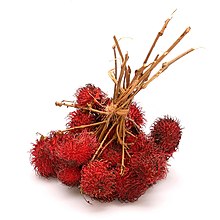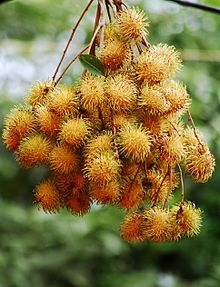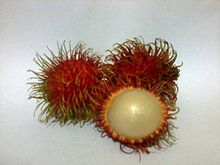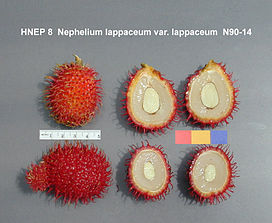| ||||||||||||||||||||||||||||||||||||
The rambutan (/ræmˈbuːtən/; taxonomic name: Nephelium lappaceum) is a medium-sized tropical tree in the family Sapindaceae. The fruit produced by the tree is also known as rambutan.
According to popular belief and the origin of its name, rambutan is native to Indonesia and Malaysia. The earliest record of rambutan trees show that they were cultivated by the Malayan jungle tribes around their temporary settlements, a practice followed to date.[3] Rambutan trees grow naturally inThailand, Vietnam, the Philippines, and elsewhere in Southeast Asia, although its precise natural distribution is unknown.[4] It is closely related to several other edible tropical fruits including the lychee, longan, and mamoncillo.[4] It is native to the Indonesian Archipelago,[5] from where it spread westwards to Thailand, Burma, Sri Lanka and India; northwards to Vietnam, and the Philippines.[4]
A species regularly sold in Costa Rican markets may be known as "wild" rambutan. Yellow in color, it is smaller than the usual red variety. The flesh exposed when the outer skin is peeled off is sweet and sour, slightly grape-like and gummy to the taste. In Panama and Costa Rican Spanish, it is known as mamón chino ("Chinese Sucker") due to its Asian origin and the likeness of the edible part with Melicoccus bijugatus. The fruit has been successfully transplanted by grafting in Puerto Rico.[4]
Rambutans are a non-climacteric fruit—that is, they ripen only on the tree.[4]
Contents
[hide]Etymology[edit]
The name rambutan is derived from the Malay/Indonesian word rambutan, meaning "hairy"[4] rambut the word for "hair" in both languages, a reference to the numerous hairy protuberances of the fruit, together with the noun-building suffix -an.[3] In Vietnam, it is called chôm chôm (meaning "messy hair") due to the spines covering the fruit's skin.[6]
Description[edit]
It is an evergreen tree growing to a height of 12–20 m.[4] The leaves are alternate, 10–30 cm long, pinnate, with 3–11 leaflets, each leaflet 5–15 cm wide and 3–10 cm broad, with an entire margin. The flowers are small, 2.5–5 mm, apetalous, discoidal, and borne in erect terminal panicles 15–30 cm wide.[4]
Rambutan trees are either male (producing only staminate flowers and, hence, produce no fruit), female (producing flowers that are only functionally female), or hermaphroditic (producing flowers that are female with a small percentage of male flowers).
The fruit is a round to oval drupe 3–6 cm (rarely to 8 cm) tall and 3–4 cm broad, borne in a loose pendant cluster of 10–20 together. The leathery skin is reddish (rarely orange or yellow), and covered with fleshy pliable spines, hence the name rambutan, derived from the Malay word rambut, which means hairs. The fruit flesh is translucent, whitish or very pale pink, with a sweet, mildly acidic flavor very reminiscent of grapes.[4]
The single seed is glossy brown, 1–1.3 cm, with a white basal scar.[4] Soft and crunchy, the seeds may be cooked and eaten. Some folklore regards the seeds as poisonous, but tests of seed extracts reveal no toxicity to mice, even in doses up to 2500 mg/kg. The extract does show some analgesic activity, however.[7] The peeled fruits can be cooked and eaten, first the grape-like aril, then the nutty seed, with no waste.
Production[edit]
It is a popular garden fruit tree and propagated commercially in small orchards. It is one of the best known fruits of Southeast Asia and is also widely cultivated elsewhere in the tropics including Africa, the Caribbean islands, Costa Rica, Panama, India, Indonesia, the Philippines, and Sri Lanka; it is also produced in Ecuador where it is known as "achotillo" and on the island of Puerto Rico.[4] Thailand is the largest producer from Surat Thani Province Thailand. Rambutan production is increasing in Australia and, in 1997, was one of the top three tropical fruits produced in Hawaii.
The fruit are usually sold fresh, used in making jams and jellies, or canned. Evergreen rambutan trees with their abundant coloured fruit make beautiful landscape specimens.
In India, Rambutan is imported from Thailand[8] as well as grown in Pathanamthitta district of the southern state of Kerala.[9]
Quality[edit]
The best quality rambutan is generally that which is harvested still attached to the branch. It is less susceptible to rot, damage, and pests, and remains fresh for a much longer time than rambutan that has been picked from the branch.
Another indicator of quality is the ease of detachment of the flesh from the seed. An easily detachable flesh normally will have bits of the woody seed coating. Thus, it is common Malay folklore to not eat too much rambutan when one has a cough.
Cultivation[edit]
| ||||||||||||||||||||||||||||||||||||||||||||
Rambutan is adapted to warm tropical climates, around 22–30 °C, and is sensitive to temperatures below 10 °C.[4] It is grown commercially within 12–15° of the equator.[10] The tree grows well on heights up to 500 metres (1,600 ft) above sea-level and does best in deep soil; clay loam or sandy loam rich in organic matter, and thrive on hilly terrain as they require good drainage.[10] Rambutan is propagated by grafting,[10] air-layering,[10] andbudding; the latter is most common as trees grown from seed often produce sour fruit. Budded trees may fruit after 2–3 years with optimum production occurring after 8–10 years. Trees grown from seed bear after 5–6 years.
The aril is attached to the seed in some commercial cultivars, but "freestone" cultivars are available and in high demand. There is usually a single light brown seed, which is high in certain fats and oils (primarily oleic acid and arachidic acid) valuable to industry, and used in cooking and the manufacture of soap. Rambutan roots, bark, and leaves have various uses in medicine and in the production of dyes.
In some areas rambutan trees can bear fruit twice annually, once in late fall and early winter with a shorter season in late spring and early summer. In other areas like Costa Rica there is a single fruit season, with the start of the rainy season in April stimulating flowering and the fruit is usually ripe in August and September. The fragile nutritious fruit must ripen on the tree, then they are harvested over a four- to seven-week period. The fresh fruit are easily bruised and have a limited shelf life. An average tree may produce 5,000–6,000 or more fruit (60–70 kg or 130–155 lb per tree). Yields begin at 1.2 tonnes per hectare (0.5 tons/acre) in young orchards and may reach 20 tonnes per hectare (8 tons per acre) on mature trees. InHawaii, 24 of 38 cultivated hectares (60 of 95 acres) were harvested producing 120 tonnes of fruit in 1997. It has been suggested that yields could be increased via improved orchard management, including pollination, and by planting high yielding compact cultivars.
Most commercial cultivars are hermaphroditic; cultivars that produce only functionally female flowers require the presence of male trees. Male trees are seldom found as vegetative selection has favored hermaphroditic clones that produce a high proportion of functionally female flowers and a much lower number of flowers that produce pollen. There are over 3,000 greenish-white flowers in male panicles, each with 5–7 anthers and a non-functional ovary. Male flowers have yellow nectaries and 5–7 stamens. There are about 500 greenish-yellow flowers in each hermaphroditic panicle. Each flower has six anthers, usually a bi-lobed stigma, and one ovule in each of its two sections (locules).[4] The flowers are receptive for about one day but may persist if pollinators are excluded.
In Thailand, rambutan trees were first planted in Surat Thani in 1926 by the Chinese Malay K. Vong in Ban Na San. An annual rambutan fair is held during August harvest time.[11]
In Malaysia, rambutan flowers from March to July and again between June and November, usually in response to rain following a dry period. Flowering periods differ for other localities. Most, but not all, flowers open early in the day. Up to 100 flowers in each female panicle may be open each day during peak bloom. Initial fruit set may approach 25% but a high level of abortion level contributes to a much lower level of production at harvest (1 to 3%). The fruit matures 15–18 weeks after flowering.
Rambutan cultivation in Sri Lanka mainly consists of small home gardens. Malwana, a village located in the Kelani River Valley, is popular for its rambutan orchards. Their production comes to market in the months of May, June and July, when it is very common to observe seasonal traders along the streets of Colombo. Sri Lanka also has some off-season rambutan production in the months of January and February in areas like Bibile, Medagama and Monaragala.
Both male and female flowers are faintly sweet scented and have functional nectaries at the ovary base. Female flowers produce 2–3 times more nectar than male flowers. Nectar sugar concentration ranges between 18% and 47% and is similar between the flower types. Rambutan is an important nectar source for bees in Malaysia.
Cross-pollination is a necessity because anther is absent in most functionally female flowers. Although apomixis may occur in some cultivars, research has shown that rambutan, like lychee, is dependent upon insects for pollination. In Malaysia, where only about one percent of the female flowers set fruit, research revealed that no fruit is set on bagged flowers while hand pollination resulted in 13 percent fruit set. These studies further suggest that pollinators may maintain a fidelity to either male or hermaphroditic flowers (trees), thus limiting pollination and fruit set under natural conditions where crossing between male and female flowers is required.
Cultivars[edit]
There are well over 200 cultivars developed from selected clones available throughout tropical Asia. Most of the cultivars are also selected for compact growth reaching a height of only 3–5 m for easier harvesting.
In Indonesia, there are 22 rambutan cultivars identified with good quality. Five of them are leading cultivars; Rambutan Rapiah, Rambutan Aceh Lebak Bulus, Rambutan Cimacan, Rambutan Binjai, and Rambutan Sinyonya.[12]
In Nicaragua, a joint World Relief–European Union team distributed seedlings to organizations such as APAC (Ascociación Pueblos en Acción Comunitaria) in 2001 to more than 100 farmers. Some of these farmers saw the first production of rambutan from their trees in 2005–2006. The initiative is directed at the local market. However, it will be several years before growing practices and distribution are perfected. Other than seedling trees, the only known commercial cultivars in Nicaragua are R134, R162 and a Yellow Rambutan that lost its name when it was smuggled from Honduras in 2004–2005 (Frankie, J. A., Winrock International).
In the Philippines, two cultivars of rambutan are distinguished by its seed. The common rambutan seed and fruit are difficult to separate, while the Maharlika Rambutan fruit separates cleanly from the seed. The fruit taste and size of these two cultivars are identical. The Maharlika rambutan is far more popular and has a higher price.
Pollination[edit]
Aromatic rambutan flowers are highly attractive to many insects, especially bees. Flies (Diptera), bees (Hymenoptera) and ants (Solenopsis) are the main pollinators. Among the Diptera, Lucilia sp. is abundant and among the Hymenoptera, honey bees (Apis dorsata and A. cerana) and the stingless bee genus Trigona spp. are the major visitors.[4] Apis cerana colonies foraging on rambutan flowers produce large quantities of honey. Bees foraging for nectar routinely contact the stigma of male flowers and gather significant quantities of the sticky pollen from male blossoms. Little pollen has been seen on bees foraging female flowers. Although male flowers open at 6 am, foraging by A. cerana is most intense between 7 am and 11 am, tapering off rather abruptly thereafter. In Thailand, A. cerana is the preferred species for small scale pollination of rambutan. Its hair is also helpful in pollination where pollen can be hooked on and transported to female flowers.













Nenhum comentário:
Postar um comentário